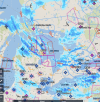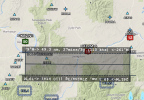The barometer at the center of the hurricane right now is 26.92", so the pressure at sea level in the eye is equivalent to the pressure at 3000' on a typical 29.92" day (about a 1000' up per inch of mercury).
To put it another way, if a plane penetrated at a constant 2900' on an altimeter set at 29.92", it'd fly into the water.
EDIT: this led me to wonder if we've lost Hurricane Hunters before. We have.
This incident is a hair raising story. Not a hurricane, didn't lose the airplane (NOAA P-3) but damn close flying in a storm at night off of Newfoundland. Single engine in a P-3 at low altitude in a storm.
The aircraft was flying at 3000 feet, 210 knots with approximately 1700-1800 SHP set on each engine. Moments later, aft crew members’ attention was drawn by flashes of light outside the starboard windows and they observed flames coming from the #3 engine tailpipe accompanied by audible “popping.” Crew members immediately notified the flight station by declaring “fire on #3, flames, flames, flames” over the ICS...
The AC advanced power slightly on engines 1, 2, and 4 to approximately 2500 SHP. The CP began to read the emergency shutdown checklist but had not completed it when the aft crew members observed flames coming from the tailpipe of the #4 engine and announced ”fire on #4”...
Approximately 3 to 5 minutes after stabilization from the shutdown of the #4 engine, the aft crew observed flames from the tailpipe of the #1 engine and announced to the flight station, “fire on #1.” ...Watching the engine RPM drop below 70% and believing he heard a direction to shut down #1, the FE pulled the Emergency shutdown handle for the #1 engine.
I've read about another too. Written from the perspective of one of the scientist crew members aboard, who ultimately hung up their flight boots immediately after they safely landed, and then went on to have a whole other career at NOAA. Interestingly, reading the NHC discussion text earlier today, it mentioned that the NOAA bird did an early RTB after encountering "severe turbulence in the SW" quadrant of the storm. I wonder if this is a euphemism for a similarly scary day out there for those folks. Don't think I've seen similar verbiage in any other such report, in spite of the verbiage being very dry and non-descriptive. Of note, the story I mention was during the workup for Hurricane Andrew IIRC, a pretty uniquely similar strong storm. They lost an engine, had another at max EGT, and couldn't climb above 7000' MSL or so. The AF hunter Herk managed to find them the path of least resistance, which they used to escape the eye before they ran out of fuel. The whole inside of the plane was trashed with all their gear being flung around.


